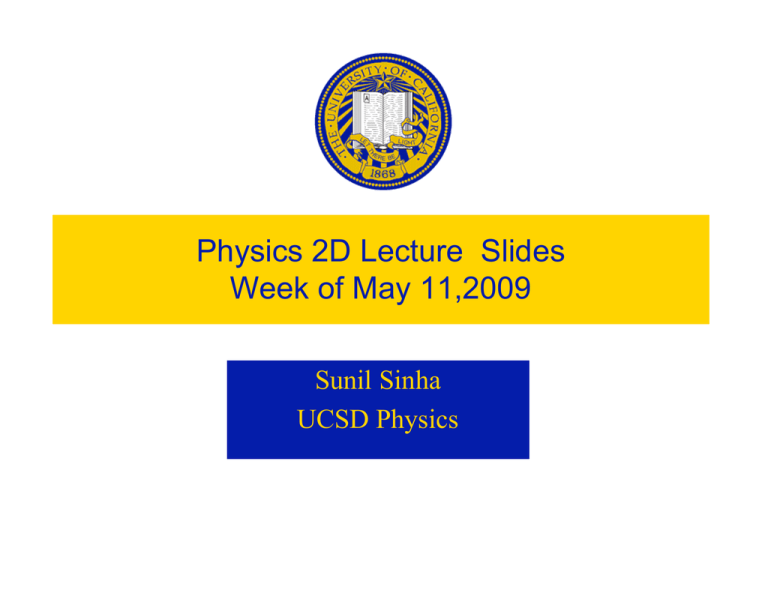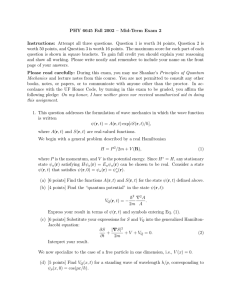Physics 2D Lecture Slides Week of May 11,2009 Sunil Sinha UCSD Physics
advertisement

Physics 2D Lecture Slides
Week of May 11,2009
Sunil Sinha
UCSD Physics
Recap!!
Wave Packet : Localization
•Finite # of diff. Monochromatic waves always produce INFINTE
sequence of repeating wave groups can’t describe (localized) particle
•To make localized wave packet, add “ infinite” # of waves with
Well chosen Ampl A, Wave# k, ang. Freq. w
! (x,t) =
$
% A(k) e
i( kx " # t )
dk
"$
A(k) = Amplitude Fn
x
& diff waves of diff k
have different amplitudes A(k)
# = # (k), depends on type of wave, media
Group Velocity Vg =
d#
dk
vgt
k = k0
localized
Group, Velocity, Phase Velocity and Dispersion
In a Wave Packet: ! = ! (k)
Group Velocity Vg =
d!
dk
k = k0
Since Vp = ! / k (def ) " ! = kV p
d!
# Vg =
= Vp
dk
k = k0
+k
dV p
dk
k = k0
usually Vp = V p ( k or! )
1ns laser pulse disperse
Material in which Vp varies with ! are said to be Dispersive By x30 after travelling
Individual harmonic waves making a wave pulse travel at
1km in optical fiber
different Vp thus changing shape of pulse and become spread out
In non-dispersive media, Vg = V p
In dispersive media Vg " V p ,depends on
dV p
dk
Matter Wave Packets
Consider An Electron:
mass = m velocity = v, momentum = p
2#
Energy E = hf =! mc 2 ; " = 2# f =
! mc 2
h
h
2#
2#
Wavelength $ = ; k =
%k=
! mv
p
$
h
d" d" / dv
Group Velocity : Vg =
=
dk
dk / dv
& 2#
&
)
2 )
mc
+
+
d"
d ( h
2# mv
dk d (
2#
2# m
=
&
=
mv + =
(
+=
(
v
v
v
dv dv (
dv dv (
+ h[1-( v )2 ]3/ 2
[1-( )2 ]1/ 2 + h[1-( )2 ]3/ 2
h[1-( )2 ]1/ 2
('
+*
('
+*
c
c
c
c
d" d" / dv
Vg =
=
= v % Group velocity of electron Wave packet "pilot wave"
dk
dk / dv
is same as electron's physical velocity
" c2
But velocity of individual waves making up the wave packet Vp = =
> c! (not physical)
k
v
Wave Packets & Uncertainty Principle
*$
!k
!# '
y = 2 A ,& cos( x "
t)) cos(kx " # t) /
2
2 (
+%
.
Amplitude Modulation
• Distance ΔX between adjacent minima = (X2)node - (X1)node
• Define X1=0 then phase diff from X1 X2 =π
Node at y = 0 = 2A cos (
$
!"
!k
t#
x)
2
2
!k.!x = 2% $ Need to combine more k to make small !x packet
also implies $
!p.!x = h
and
!" .!t = 2% $ Need to combine more " to make small !t packet
also $ !E.!t = h
What does
This mean?
Know the Error of Thy Ways: Measurement Error Δ
•
•
•
Measurements are made by observing something : length, time, momentum,
energy
All measurements have some (limited) precision`…no matter the instrument used
Examples:
– How long is a desk ? L = (5 ± 0.1) m = L ± ΔL (depends on ruler used)
– How long was this lecture ? T = (50 ± 1)minutes = T ± ΔT (depends on the accuracy of
your watch)
– How much does Prof. Sinha weigh ? M = (1000 ± 950) kg = m ± Δm
• Is this a correct measure of my weight ?
– Correct (because of large error reported) but imprecise
– My correct weight is covered by the (large) error in observation
Length Measure
Voltage (or time) Measure
Measurement Error : x ± Δx
•• rMeasurement errors are unavoidable since the measurement procedure is an experimental one
• True value of an measurable quantity is an abstract concept
• In a set of repeated measurements with random errors, the distribution of measurements
resembles a Gaussian distribution characterized by the parameter σ or Δ characterizing the width
of the distribution
Measurement error large
Measurement error smaller
Measurement Error : x ± Δx
•• rMeasurement errors are unavoidable since the measurement procedure is an experimental one
• True value of an measurable quantity is an abstract concept
• In a set of repeated measurements with random errors, the distribution of measurements
resembles a Gaussian distribution characterized by the parameter σ or Δ characterizing the width
of the distribution
Measurement error large
Measurement error smaller
Interpreting Measurements with random Error : Δ
True value
Where in the World is Carmen San Diego?
• Carmen San Diego hidden inside a big box of length L
• Suppose you can’t see thru the (blue) box, what is you best estimate
of her location inside box (she could be anywhere inside the box)
X=0
X=L
x
Your best unbiased measure would be x = L/2 ± L/2
There is no perfect measurement, there are always measurement error
Wave Packets & Matter Waves
What is the Wave Length of this wave packet?
λ−Δλ < λ < λ+Δλ
De Broglie wavelength λ = h/p
Momentum Uncertainty: p-Δp < p < p+Δp
Similarly for frequency ω or f
ω−Δω < ω < ω+Δω
Planck’s condition E= hf = hω/2
E-ΔE < E < E + ΔE
Back to Heisenberg’s Uncertainty Principle & Δ
• Δx. Δp ≥ h/4π ⇒
– If the measurement of the position of a particle is made with a
precision Δx and a SIMULTANEOUS measurement of its momentum
px in the X direction , then the product of the two uncertainties
(measurement errors) can never be smaller than ≅h/4π irrespective of
how precise the measurement tools
• ΔE. Δt ≥ h/4π ⇒
– If the measurement of the energy E of a particle is made with a
precision ΔE and it took time Δt to make that measurement, then the
product of the two uncertainties (measurement errors) can never be
smaller than ≅h/4π irrespective of how precise the measurement tools
These rules arise from the way we constructed the
Wave packets describing Matter “pilot” waves
Perhaps these rules
Are bogus, can we verify
this with some physical
picture ??
The Act of Observation (Compton Scattering)
Act of observation disturbs
the observed system
Compton Scattering: Shining light to observe electron
Light (photon)
scattering
λ=h/p= hc/E
= c/f off an electron
I watch the photon as it enters my eye
The act of Observation DISTURBS
the object being watched,
here the electron moves away from
where it was originally
hgg
g
Diffraction By a Circular Aperture (Lens)
See Resnick, Halliday Walker 6th Ed, Ch 37, pages 898-900
Diffracted image of a point source of light
thru a lens ( circular aperture of size d )
First minimum of diffraction pattern is
located by
!
sin " = 1.22
d
Resolving Power of Light Thru a Lens
Image of 2 separate point sources formed by a converging lens of
diameter d, ability to resolve them depends on λ & d because of the
Inherent diffraction in image formation
d
ΔX
Not resolved
barely resolved
resolved
!
Resolving power #x !
2sin"
ϑ Depends on d
Putting it all together: act of Observing an electron
Observed
Diffraction
pattern
•
•
•
Incident light (p,λ) scatters off electron
To be collected by lens γ must scatter thru angle α
•
-ϑ ≤α≤ϑ
Due to Compton scatter, electron picks up momentum
•PX , PY
h
h
sin ! $ Px $ sin !
"
"
electron momentum uncertainty is
~2h
%p &
sin !
"
#
Photons that go thru are restricted
to this region of lens
Eye
•
•
After passing thru lens, photon diffracts, lands
somewhere on screen, image (of electron) is fuzzy
How fuzzy ? Optics says shortest distance between two
resolvable points is :
#x =
•
!
2sin "
Larger the lens radius, larger the ϑ⇒ better resolution
# 2h sin ! $ # "
* %p.%x " &
'&
"
(
) ( 2sin !
* %p.%x + ! / 2
$
'=h
)
Pseudo-Philosophical Aftermath of Uncertainty Principle
• Newtonian Physics & Deterministic physics topples over
– Newton’s laws told you all you needed to know about trajectory of a
particle
• Apply a force, watch the particle go !
– Know every thing ! X, v, p , F, a
– Can predict exact trajectory of particle if you had perfect
device
• No so in the subatomic world !
– Of small momenta, forces, energies
– Can’t predict anything exactly
• Can only predict probabilities
– There is so much chance that the particle landed here or there
– Cant be sure !....cognizant of the errors of thy observations
Philosophers went nuts !...what has happened to nature
Philosophers just talk, don’t do real life experiments!
All Measurements Have Associated Errors
• If your measuring apparatus has an intrinsic inaccuracy
(error) of amount Δp
• Then results of measurement of momentum p of an
object at rest can easily yield a range of values
accommodated by the measurement imprecision :
– -Δp ≤ p ≤ Δp
• Similarly for all measurable quantities like x, t, Energy !
Matter Diffraction & Uncertainty Principle
x
Y
Incident
Electron beam
In Y direction
Momentum measurement beyond
slit show particle not moving exactly
in Y direction, develops a X component
Of motion ΔPX =h/(2π a)
Probability
slit size: a
ΔPX
0
X component PX of momentum
Particle at Rest Between Two Walls
•
•
Object of mass M at rest between two walls originally at infinity
What happens to our perception of Dick as the walls are brought in ?
L
m
0
Dick’s Momentum p
On average, measure <p> = 0
but there are quite large fluctuations!
Width of Distribution = !P
!
!P = ( P 2 ) ave " ( Pave ) 2 ; !P "
L







